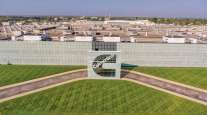Senior Reporter
Cummins Recalls 500,000 Trucks for Emission Control Catalyst Failures

Engine maker Cummins Inc. announced it will voluntarily recall 500,000 model-year 2010-15 medium- and heavy-duty trucks to replace a defective catalyst in the emissions control system.
The campaign is the largest voluntary recall of medium- and heavy-duty trucks ever, according to the U.S. Environmental Protection Agency.
This comes after a recall begun in 2016 of 232,000 Dodge Ram 2500 and 3500 vehicles with pre-2013 Cummins engines. Recalls for those vehicles were approved in July 2016 and July 2017, respectively, and are underway. Those vehicles and the latest medium- and heavy-duty trucks all produce excessive amounts of smog-forming nitrogen oxide.
However, Cummins does not find itself in a Volkswagen situation, in which a defeat device on VW models intentionally increased the engine emissions under certain conditions, Glen Kedzie, energy and environmental counsel for American Trucking Associations, told Transport Topics.
“This was actually a faulty emission control device that degraded faster than it was supposed to and as a result emitted higher levels of NOx than were permitted,” Kedzie said.
About 60 engine families are involved in the recall found in a wide range of vehicles, from big rigs, to larger pickup trucks and some buses, the California Air Resources Board said.
Cummins has set aside $404 million to cover all related expenses; $181 million of that is slated for the latest recall.
“In determining the best course of action to support our customers, we have elected to increase the number of aftertreatment systems to be addressed through hardware replacement compared to our estimate last quarter,” Cummins Chairman and CEO Tom Linebarger said in an earnings conference call with analysts July 31.
“This issue does not affect any of our current products, which are performing very well and our market share remains strong,” Linebarger added.
At the same time, the effect of the recall on fleets will be a mixed blessing, one industry expert said.
“This recall is bittersweet to the industry. Bitter because it will be yet another cause of decreased asset utilization impeding profits [when freight-hauling demand is at record levels]. Sweet due the fact it will give them some relief on their maintenance expense,” said Michael Buck, president of MCB Fleet Management Consulting, which is based in St. Simons, Ga.
Cummins always has stood behind its products, he said. But the question is, do they really know the cause of the defective component?
“The shortened life span of the component can be caused by poor preventive maintenance on upstream components or other components within the aftertreatment system, placing undue demands on the SCR catalyst. The environment in which these components must survive is quite severe,” Buck said.
The issue with the medium- and heavy-duty trucks came to light in CARB’s routine in-use testing of 14 vehicles, eventually, with one engine family from Cummins. The agency used portable emissions measurement systems on the trucks operating on streets and highways under typical operating demands and conditions.
“We didn’t test the full range of vehicles that were affected,” said Sharon Lemieux, chief of the in-use programs branch in the Emissions Compliance, Automotive Regulations and Science Division at CARB.
“Technically, if Cummins wanted to, they could make us test every engine family that was equipped with that bad catalyst. So we did have rock-solid compliance data on one engine family, and there are actually 60 engine families that are affected [in the nearly 800,000 vehicles]. It was pretty significant,” she said.
“To have Cummins step up and do the right thing and recall all the rest of them, we thought it was pretty good of them to do that,” she added.
CARB does not know the total amount of excessive NOx released by all the vehicles, Lemieux said.
About 34,000 of the recalled trucks operate in California, but that number could rise based on additional registration data, she said.
The latest recall — given its scale — will occur in two phases, the first beginning Aug. 1. “Owners of the 500,000-plus affected vehicles will receive letters with instructions on how to get their catalysts replaced or receive reimbursement for the cost of the replacement,” according to CARB. The second phase begins in March 2019.
Cummins did not immediately disclose how many were medium-duty and how many were heavy-duty trucks.
The industry is experienced with component failures that create “havoc” and is pretty good at managing through the process, said Darry Stuart, principal at DWS Fleet Management in Wrentham, Mass.
At the same time, “I think it is going to open up Pandora’s Box for those people who enjoy litigation,” he said.




